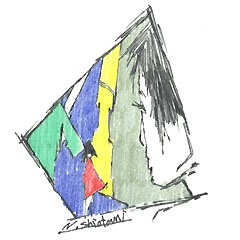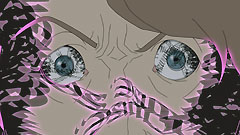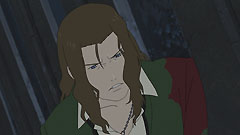Les 24 Chevaliers Part XXI: Naoyoshi Shiotani (Episode Director)
In this last interview dedicated to the episode directors of Le Chevalier D'Eon, we have met Naoyoshi Shiotani, who actually tested his potentials as a director for the first time in Episode 18. This interview was recorded before he started to work on Tokyo Marble Chocolate.
Part XXI
Naoyoshi Shiotani's In principio erat Verbum: "Pioneer"
 | Naoyoshi Shiotani Episode director. Born in 1977, he's one of Production I.G's most promising young creators. His main works include Windy Tales (2004) and Blood+ (2005), and served as key animator in a number of I.G works, such as Otogi Zoshi (2004), The Prince of Tennis - Two Samurai: The First Game (2005), Tsubasa Chronicle - The Princess of the Birdcage Kingdom (2005) and Reideen (2007). The visually experimental third opening sequence for the TV series Blood+ that he directed in 2006 was selected in competition at the 11th Holland Animation Film Festival. In 2007, he made his directorial debut in a narrative work with Tokyo Marble Chocolate. He's a soft-spoken nice guy with a naughty boy inside. |
What made you decide to join the Le Chevalier D'Eon project?
I had worked for Producer Nakatake at the time of Tsubasa Chronicle, so when I heard about his new TV series he was working on, Le Chevalier D'Eon, I was thrilled to see how it would turn out. And when I saw the finished pictures, I thought, "Wow, they sure are doing some pretty tough stuff!" But at that time, I had no idea I would be in it, too. (lol)
Then a while later, Nakatake-san came to me. He was quite excited and said, quot;You know what? This script is fantastic! Would you like to direct it?" He was talking about Episode 18. Then I read the scripts for the previous episodes as well. They were fabulous. I hadn't seen a TV series in a long time that made me crave for the next episode. I had never been responsible for the whole process from storyboards to directing one entire 30-minute TV episode. So I thought, sure, let's give it a try! I wanted to challenge myself to the task of turning that amazing script into an entertaining film.
This was your first shot at directing a TV series episode. How do you compare this task with your previous endeavors?
I don't think there are clear differences. Since I draw the storyboard myself, I have the final film in my head. So taking aside the process in between, if I have the solid idea of pictures and sound to build up to, I figured I had a chance. You see, the opening sequences and short movies are self-contained projects and have no relation to the flow of the story. But this project is a part of a series, so I had to think of the storyline of the entire series. Take, for example, if you are working on a score, you don't just work on the climax, but you have to create diverse rhythms that will lead to it. I hoped to accomplish that in this project.
Episode 18, which I worked on, opens with a fight, then continues with political exchanges at Versailles, activities behind the scenes, more fights in Medmenham, an intense conversation, death and other amazing events I won't reveal here. So I had to deal with action sequences, orthodox drama scenes, and even supernatural phenomena. Initially, I was worried I might not be able to put in every element that the script covered, but it worked out OK. (lol)
I realized that my storyboard was quite bulky if compared to the other episodes, but I needed every page of it in order to expand my ideas. In the end, I learned that structurally speaking, the standard twenty-minute format for a TV series episode may sound long but it is definitely not, and you run out of time quite easily. Another thing is that I had to think well ahead how I would allocate time to work on each section within the tight schedule I was given. That was critical to raise the quality of the final work. Therefore, I had to keep this in mind and plan everything at storyboard stage, and make sure things were under control. At any rate, I wanted to reduce the number of retakes by creating good pictures, but at the same time I tried to reduce the burden on each staff member.


How were the meetings with the staff?
At the storyboard meeting, Director Furuhashi commented, "Since this episode focuses on Dashwood, please portray him not simply as a straightforward villain, but also as someone the audience can relate to." That's it and he let me do whatever I wanted to do right from the start to the end. I did not meet in person with Shotaro Suga who wrote the script, but he did see my finished storyboard, and told me: "they are identical to my own images. I look forward to seeing the completed work." I was honored and felt relieved.
I also have to add that all the animators helped me a lot. I originally come from I.G Studio 2 under Kazuchika Kise. So when I, as the episode director, had to go and ask Kise-san to do the key animation for the episode, I was understandably very nervous. (lol) But that really paid off. With this participation of a veteran key animator, I think we had a super good animation. To tell you the truth, while I was directing episode 18, my desk was right next to the animation director Kyoji Asano's desk. This was Producer Nakatake's idea. We could talk to each other and decide on the details right there, so it was smooth sailing. Basically, we shared responsibilities: I did the layouts and asked Asano-san to do the motion and actions.
But what surprised me the most was the acoustics. Actually, there is very little background music in this episode, because I wanted to highlight the ending music. I think that went very well. When I saw the finished film, I got quite emotional when the ending music started.
What was the theme that you wanted to get across in this episode?
For this project, I was careful not to hear about the storyline after this episode. If I knew the forthcoming scenario beforehand when I drew the storyboards, they would be biased with that knowledge. I wanted to portray the emotion and psychology of the characters at that point of the series timeline called "Episode 18." And I also wanted to give an opportunity for each one of the Four Musketeers to demonstrate their full potential.


As for the pile of rubble in the other-dimensional world, I included a number of elements that simbolically alluded to the French Revolution. It is not a depiction of historical facts, but rather the nightmerish image Dashwood saw, and could have been France at the time or in the future. I did not want to impose upon the audience with a fixed idea. I did use images of the Tricolor to symbolize freedom and human rights, but I did not convey a definite statement about the image of the other-dimensional world so that the audience could think for themselves. I tried to make the audience feel, "well, that was a strange experience." And I also wanted to draw people's attention to Durand in this episode. I hope you can feel his frustration on the screen.
Who is your favorite character?
I like Durand, but I would put Dashwood first, because I kept on drawing him all through this project. (lol) I personally think he was not a total villain.

What did you gain from this project? What would you like to do in the future with the experience you gained here?
I gained quite a lot from Le Chevalier D'Eon. Before this project, I only worked as an animator, so I basically focused on the sequence I was allotted. I was only responsible for that section. But as an episode director, I could work on the episode holistically. Allocating time for each section while keeping the whole process from drawing animations to finishing in mind lead to lifting up the quality of the entire work. I learned this was the key to completing the work as I intended.
There is a common technique to switch cameras to show the tension, for instance, between characters that face each other. In the sequences where I worked on, I only used that technique when Dashwood confronted Lia. I intended to have that particular sequence to stand out with that camera work and make an impression on the viewers. In order to avoid using that particular camera technique in other sequences, I tried methods such as shifting the camera angles.
I like films by Director Kon Ichikawa, so I guess I am influenced in the ways I structure the sequences. Each sequence might seem to lack stability. That is because I wanted to create different rhythms within the flow of the whole episode storyline. You might notice that the other-dimensional world is more or less made up of ordinary camera angles. This was aimed at making strange objects stand out from the ordinary.




What's next in Naoyoshi Shiotani's schedule? Animator or director?
I have variety of dreams for the future. After working as an episode director for this project, I felt that working on a series was fun. I am interested in working as a series director. These jobs are like conducting an orchestra. That is to set the rhythm for the entire staff so that every part will come together to make a complete work. I wish I could do that in the films I create.
Lastly, please leave a message for the viewers.
I believe that Le Chevalier D'Eon is a great piece of work. It's really fun. I'd like people from all walks of life to see it. I think impressions are different when you see the weekly broadcast and when you see it again from start to finish, so I hope you will see it over and over again from different perspectives. I was personally watching it as a fan myself!
© Tow Ubukata · Production I.G/Project Chevalier 2006

![WORK LIST[DETAILS]](/contents/works/design/images/left_title.gif)



 terms of use
terms of use